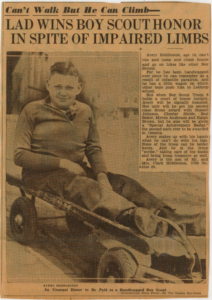As our strange summer of 2020 moves on, with face-masks and distancing policies still in place to slow the spread of the coronavirus, some of our members may be reminded of summers 50 years ago when outbreaks of polio closed public pools and movie theaters every summer, and when parents hesitated to let their children go outside for fear that they might become one of the hundreds of Omaha children hospitalized.
Poliomyelitis, commonly known as polio, first appeared in America in 1894 as an isolated outbreak in Vermont. It quickly spread through the rest of the country, flaring up every year during “polio season” from May to September. An outbreak in Nebraska caused over 600 cases in 1909, including 79 in Douglas County. Polio cases increased during the first half of the century, causing anxiety in parents and communities, as it struck without warning, often afflicting children, and leaving thousands of survivors with lifelong paralysis.1
DCHS was recently contacted by the family of Avery Hiddleston, an Omaha native who contracted polio as an in infant in 1921. The family donated several of Avery’s affects, including his leg braces, which he wore for the majority of his life. The braces, pictured below, were padded and altered to fit his legs. He would have laced them up at the foot, calf, and thigh every morning. Even though lighter, modern braces were available later in Avery’s life, he preferred this original pair.
Avery survived a bout of polio in 1921, which left both of his legs paralyzed and his left arm weakened. However, he still attended the same school – Lothrop Elementary – as his siblings and neighbors. He traveled there in a wagon pulled by his brother and friends, and then the boys lifted him on their shoulders up the steps of the school. He played first base in neighborhood baseball games, using his stronger right arm to catch, then tucked the mitt under his left arm, so he could throw using the stronger arm. He was called “Zeke” after Zeke Bonura, a well- known first baseman in the 1930s.
Avery was a member of his local Boy Scout troop and was given a Special Achievement Badge in 1935, in addition to his second class scout award.
As a teenager, Avery missed a year of school to recover from an operation to straighten his legs. This procedure allowed him to walk with the assistance of leg braces and crutches. He was also an avid traveler and loved driving. He bought a Ford modified with hand controls for amputees, and drove all over Omaha and on vacation. Even in his later years, when he was confined to a wheelchair, he drove a van that allowed him to drive from the chair – “wheels on wheels”, he laughingly called it.
Avery passed away in 1998 and his braces were left with his niece, Sandy Kerr. Sandy donated them and shared the story of her Uncle Zeke with us because she wanted a place for his story to be remembered and preserved for the future. We are pleased to accept this donation into our collection and to share his story with our members.
Sources:
- McCLANAHAN HM. A BRIEF REPORT OF THE NEBRASKA EPIDEMIC OF POLIOMYELITIS. JAMA. 1910;55(14):1160–1162. doi:10.1001/jama.1910.04330140004002. Accessed July 30, 2020.

